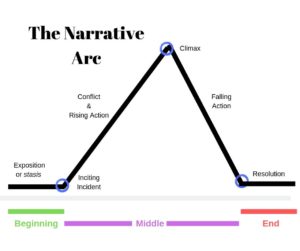An in-depth look at the what, how and why of brand storytelling, and its relevance as a content marketing strategy for all business owners and copywriters.
____
Once upon a time, in a city far, far away, there lived a kindly business owner. Every morning she made a cup of strong coffee then sat down and checked her emails.
Every morning they consisted of much the same: a host of client inquiries, requests for quotes, and feedback from (mostly) satisfied customers.
But one morning, she turned on her computer and no emails arrived.
She checked her internet connection—it was working. She closed and reopened her emails. Still nothing. She checked her phone—no missed calls.
What was going on? Where was the usual influx of client inquiries wanting her services?
They were gone.
She hurriedly checked her analytics and found customer engagement at an all-time low. Click rates were decreasing as readers scrolled past her updates.
Over the next few weeks, this kindly business owner racked her brains. She tried and tried to reach her customers once again.
She launched a new email campaign.
She doubled the frequency with which she posted social media updates.
She cold called and cold emailed until her fingers ached.
But to no avail.
Finally, in desperation, she reached out to an old customer, gently demanding they explain their loss of interest in her business.
“You’re just not relevant or relatable anymore.”
The poor business owner cried her heart out. She had always tried to be relatable. She wanted her customers to be happy—after all, they were saving money from her services. What more could she do?
Had she lost sight of why she had started her business in the first place?
The next morning, she sat at her computer. But she didn’t open her emails. She didn’t check her phone.
Instead, she opened a new document and began to type.
She typed and typed, writing and writing until the sun disappeared and the day was gone. Then she sat back and read.
And what she read was a story.
Her story.
The story of her business—from its very beginning, its tiny foundations, its trials and stumbling blocks. Then the joy at finding her first customer, the satisfaction at sending her first e-newsletter to real subscribers. How the business grew and grew. Its failures and successes, peaks and troughs.
She realised suddenly that this loss of engagement was nothing more than another trough. She had experienced others and had always persevered.
That was the nature of her business—continuing against the odds.
That was her brand and its story.
She published her story—and not just the good bits. All of it. The honest, real account of her business. Over time, she worked it into the very identity of her business.
And, sure enough, her customers came back.
She had become relatable again.
She yes, she did live happily ever after (or something like that).
Introduction
There are a variety of reasons why crafting and sharing your brand story is important—both for internal engagement amongst the employees of your business as well as for longer term connections with external clients.
Not all business stories will start and progress like the one above (which is entirely fictional, by the way). And not all stories need to be stories of adversity and struggle. But they do need to have certain features to make them appeal to customers and employees alike.
But before looking at these features, we first need to fully understand what is meant by the term ‘business storytelling’.

What is business storytelling?
In a recent article on corporate storytelling by Matt Press at Splash Copywriters, Press describes storytelling as ‘strategically using content’ (read the whole article here). And this is quite true.
In essence, it’s about sharing your brand’s principal message—its very identity—in a way which helps customers to connect with your business on more than a superficially financial level. ‘A brand story is designed to connect a business with a customer and deepen the relationship between them,’ Press explains.
A refined, well-crafted, articulate business story will connect on an emotional level to your customers. And, as we will explore, emotion drives action.
But how do you write a refined, well-crafted and articulate story?
Apart from a lot of red-penning and copious drafts, there is a basic story framework which can assist.
A refined, well-crafted, articulate business story will connect on an emotional level to your customers.
How do I craft a compelling story?
Ask yourself, what does a story look like?
This might be a strange question. Surely stories don’t look like anything more than words on a page.
But, in fact, a story will generally have a shape.
Most stories—including many well-known fairytales and other loved fables—follow a particular framework which drives the action forward and ensures the story connects emotionally with its readers.
This framework is called a “story arc” or a “narrative arc”.
In essence, a story arc will follow a pattern of steps something like this:
- Beginning
- Exposition or stasis (how life is at the start of the story)
- Inciting incident (something happens to alter that life described at the start). This is where the story moves into its ‘middle’
- Rising action (things get more and more problematic or tense, usually due to the effects of the inciting incident)
- Climax (highest point of tension in the story, often a lot of action here)
- We begin to move towards the end of the story with what is often called ‘falling action’ (things are beginning to resolve themselves after the point of climax
- Resolution (happily ever after, or some sort of closure)
The shape of the story will look something like Figure 1.

Figure 1 – The Story Arc
A great article on this is Donna Lichaw’s piece on crafting narrative arcs.
Once you have a first draft of your brand story, measure it against the narrative arc and make changes to ensure it fits.
For any interested readers, you can take the fictional story at the beginning of this article and plot it against the story arc in Figure 1. It will fit.
Why is all this important to my business and its brand story?
Good question.
Right, let’s get to the nitty gritty.
Overall, it is about connecting your business to your potential customers on an emotional level to ensure your brand is not forgotten.
‘Every brand has a message (or several) that they wish to communicate,’ Press explains. ‘Content marketing allows them to do so. And if that message is contained within a story, it’s much more likely that it will be noticed and remembered.’
Why is this the case?
Simply put, it’s about emotion.
How can my business benefit from brand storytelling?
Like SEO, brand storytelling involves planning an approach to copywriting and content marketing for the long term.
Establishing your business story is hard work. It is more than simply throwing words at a page till enough of them stick to make a few paragraphs, then publishing those paragraphs on your website’s About Us page.
That is a start but, if it’s all you do with the story, it becomes a bit tokenistic.
To reap the real benefits of brand storytelling in your business, the story must become part of the very identity of your business. It needs to be real, simple and consistent.
Matt Press reminds us that people will buy the “why” and not the “what”.
They aren’t really buying your product or service, they are buying the idea of what the product or service will do to make their lives better.
I’m a copywriter. What’s my role in this?
Business storytelling is becoming increasingly popular and, therefore, increasingly essential for copywriters to understand as a content marketing strategy.
When briefing your client, ask questions beyond those directly related to the campaign they are asking you to create. Ask them about their company’s history, about their own role in the company’s growth, high and low points and, importantly, why they began their business.
Just as a customer will be interested in why they ought to buy a product, so too will you need to understanding why the business selling that product exists. What is its purpose? Its raison d’être (just fancy French for its ‘reason for being’)?
Creative writing is unquestionably part of the job of a copywriter.
You may not have formally studied the craft of writing. You might not be able to differentiate between point of view and voice.
But you are a creative writer.
Whether you realise it or not, each time you craft a winning headline, you are—consciously or unconsciously—writing copy which appeals to the emotions of the potential reader.
You are already using the tools you need to write your clients’ business stories.
But I’m not a novelist! What features make a good business story?
We’ve already discussed the overall framework for crafting your business story using a narrative arc.
But there are certain characteristics your business story should include to make it compelling and to serve its purpose as a content marketing strategy.
Tips for writing a captivating business story

- Start with a hook
Want your reader to get to the end? Keep them entertained. From. The. First. Sentence. Start with action, or humour, or whatever best fits your brand’s tone. Remember that most readers skim when reading web articles. Make the hook so good that they can’t stop reading and don’t feel the need to skim.
- Be real
In an article published on Convince & Convert, Kathy Klotz-Guest (founder of Keeping It Human) explains that one key way to help your brand story to stand out in the ocean of content being tossed around on the internet is to ensure you—for want of a better phrase—keep it real. This is because ‘it needs to get vulnerable, real, and drop the perfect endings. Tidy resolutions make for crummy stories.’ (Read the whole article here.)
- Make it a human story
That is, make the story personal. ‘Companies can’t be protagonists,’ Klotz-Guest explains. ‘People don’t care about companies. They care about people.’ So, when plotting your character arc, ensure you are telling your business story through the eyes of an individual person who is your protagonist.
That person might be an employee. Or they might be a customer.
But it must be a story which will connect with others on an emotional, personal level. Remember, real, personal stories are messy. Like life.
They produce emotions. Like life does.
Readers know that. That’s why they like the story.
- Keep a consistent tone of voice
If you begin your story using formal language but change halfway through to be chatty and familiar, your readers will be confused about the overall tone of your business itself. Give some thought before you write the story to your brand’s tone and ensure it is accurately reflecting in your writing.
- Give it a future direction
Ensure your business story isn’t just set in the past. Your readers will want to know what is happening now, and what they can expect your brand to do, moving forward. Ensure you include what’s happening next for you and your business.
- End it well
Ending a brand story by stating that your customer (who might be the protagonist in your tale) will be financially better off doesn’t work. ‘Economic benefit is a terrible ending for a story,’ Klotz-Guest says. Rather, a customer wants to know how buying your product or service will benefit them emotionally. ‘They want hope that they will be better… Money is only a means to an end. Find those passions and go there,’ she advises.
Getting from emotion to action
Theresa M. Welbourne, in her 2015 article on using data-driven storytelling in business (read it here), states, ‘Storytelling is an art form that leaders use to inspire and drive action.” She explains that this it is an effective approach because ‘researchers who study the brain tell us that in order to drive action, we need emotion.’
So, emotion prompts action.
What action do you, as a business owner, want your potential customers or clients to take?
Know this.
And know your customer. Who is she? What does he like? What does she need? How does he want to be or feel?
Work out how your business answers those questions.
If so, the emotional connection made when a customer reads your brand story would hopefully lead them towards buying your product or service. A neat way to encourage this transition from reader to customer is by including a Call To Action at the end of your story. Encourage them to join you, to work with you, or to buy from you.
Concluding Thoughts
There are many aspects to consider in planning and writing your business story. Storytelling isn’t new; it’s been a crucial cultural element and important means of communication for thousands of years. So rest assured you are in good company.
Now go and grab a piece of paper and a pen.
Citations & References
Kathy Klotz-Guest, 7 Ways to Make Your Business Storytelling Awesome. Convince & Convert. https://www.convinceandconvert.com/digital-marketing/make-business-storytelling-awesome/, accessed 23 May 2019.
Donna Lichaw, How to Craft a Narrative Arc. Donna Lichaw. https://www.donnalichaw.com/blog/2014/8/7/how-to-craft-a-narrative-arc, accessed 23 May 2019.
Matt Press, Corporate storytelling: how stories can make people fall in love with your brand and become customers. Splash Copywriters. https://www.splashcopywriters.com/blog/corporate-storytelling#Section%201, accessed 24 May 2019.
Theresa M. Welbourne, ‘Data-Driven Storytelling: The Missing Link in HR Data Analytics’ in Employment Relations Today. Winter 2015. https://doi.org/10.1002/ert.21471


1 thought on “A Likely Story: The Power of Business Storytelling”
Comments are closed.